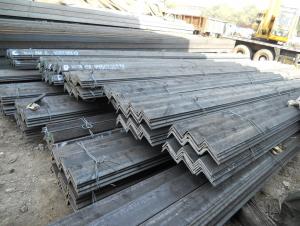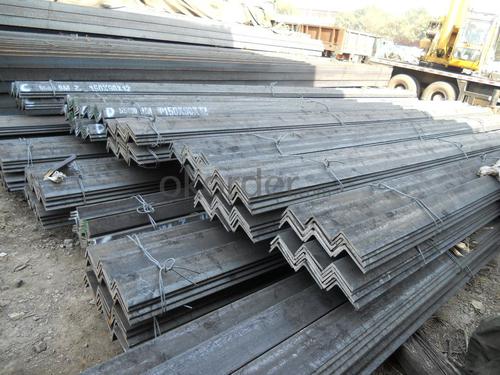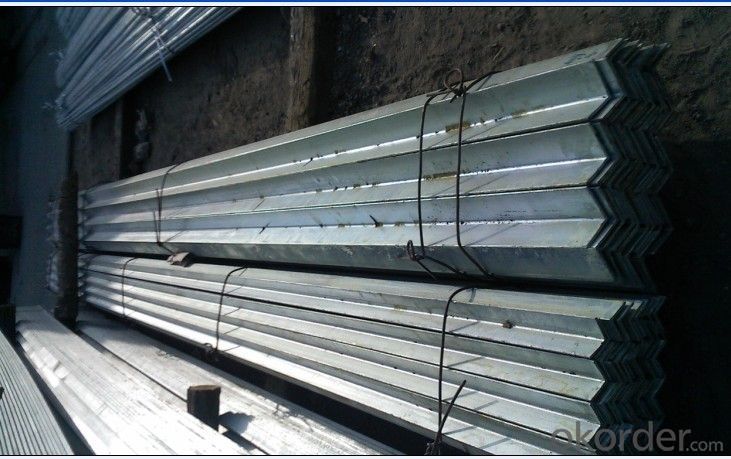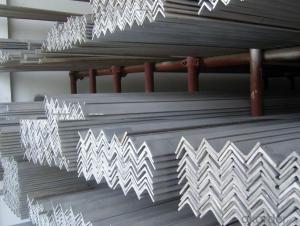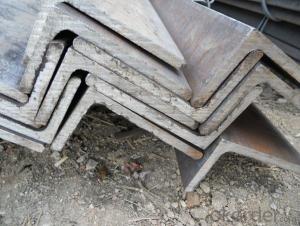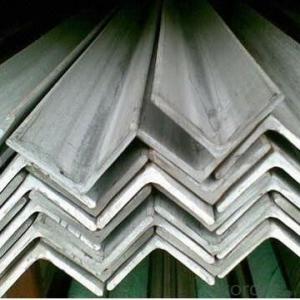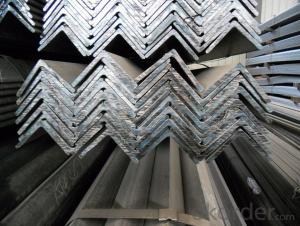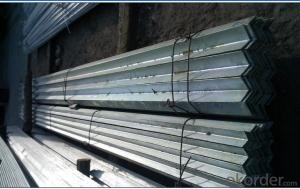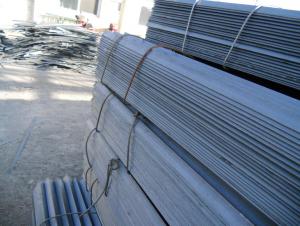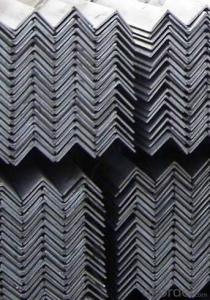Low Carbon Prime Steel Unequal Angle Bars
- Loading Port:
- Tianjin
- Payment Terms:
- TT or LC
- Min Order Qty:
- 100 m.t.
- Supply Capability:
- 20000 m.t./month
OKorder Service Pledge
OKorder Financial Service
You Might Also Like
OKorder is offering Low Carbon Prime Steel Unequal Angle Bars at great prices with worldwide shipping. Our supplier is a world-class manufacturer of steel, with our products utilized the world over. OKorder annually supplies products to African, South American and Asian markets. We provide quotations within 24 hours of receiving an inquiry and guarantee competitive prices.
Product Applications:
Low Carbon Prime Steel Unequal Angle Bars are ideal for structural applications and are widely used in the construction of buildings and bridges, and the manufacturing, petrochemical, and transportation industries
Product Advantages:
OKorder's Low Carbon Prime Steel Unequal Angle Bars are durable, strong, and wide variety of sizes.
Main Product Features:
· Premium quality
· Prompt delivery & seaworthy packing (30 days after receiving deposit)
· Can be recycled and reused
· Mill test certification
· Professional Service
· Competitive pricing
Product Specifications:
Manufacture: Hot rolled
Grade: Q195 – 235
Certificates: ISO, SGS, BV, CIQ
Length: 6m – 12m, as per customer request
Packaging: Export packing, nude packing, bundled
| UNEQUAL ANGLE STEEL | |||||
| size(mm) | a(mm) | a1(mm) | thickness(mm) | kg/m | length(m) |
| 75*50*5 | 75 | 50 | 5 | 4.808 | 6m,9m,12m |
| 75*50*6 | 75 | 50 | 6 | 5.699 | 6m,9m,12m |
| 75*50*8 | 75 | 50 | 8 | 7.431 | 6m,9m,12m |
| 100*75*7 | 100 | 75 | 7 | 9.34 | 6m,9m,12m |
| 100*75*8 | 100 | 75 | 8 | 10.6 | 6m,9m,12m |
| 100*75*9 | 100 | 75 | 9 | 11.8 | 6m,9m,12m |
| 100*75*10 | 100 | 75 | 10 | 13 | 6m,9m,12m |
| 100*75*12 | 100 | 75 | 12 | 15.4 | 6m,9m,12m |
| 125*75*7 | 125 | 75 | 7 | 10.7 | 6m,9m,12m |
| 125*75*8 | 125 | 75 | 8 | 12.2 | 6m,9m,12m |
| 125*75*9 | 125 | 75 | 9 | 13.6 | 6m,9m,12m |
| 125*75*10 | 125 | 75 | 10 | 15 | 6m,9m,12m |
| 125*75*12 | 125 | 75 | 12 | 17.8 | 6m,9m,12m |
| 150*90*8 | 150 | 90 | 8 | 14.7 | 6m,9m,12m |
| 150*90*9 | 150 | 90 | 9 | 16.4 | 6m,9m,12m |
| 150*90*10 | 150 | 90 | 10 | 18.2 | 6m,9m,12m |
| 150*90*12 | 150 | 90 | 12 | 21.6 | 6m,9m,12m |
| 200*100*10 | 200 | 100 | 10 | 23 | 6m,9m,12m |
| 200*100*12 | 200 | 100 | 12 | 27.62 | 6m,9m,12m |
| 200*100*15 | 200 | 100 | 15 | 34.04 | 6m,9m,12m |
FAQ:
Q1: Why buy Materials & Equipment from OKorder.com?
A1: All products offered byOKorder.com are carefully selected from China's most reliable manufacturing enterprises. Through its ISO certifications, OKorder.com adheres to the highest standards and a commitment to supply chain safety and customer satisfaction.
Q2: How do we guarantee the quality of our products?
A2: We have established an advanced quality management system which conducts strict quality tests at every step, from raw materials to the final product. At the same time, we provide extensive follow-up service assurances as required.
Q3: How soon can we receive the product after purchase?
A3: Within three days of placing an order, we will arrange production. The normal sizes with the normal grade can be produced within one month. The specific shipping date is dependent upon international and government factors, the delivery to international main port about 45-60days.
Images:
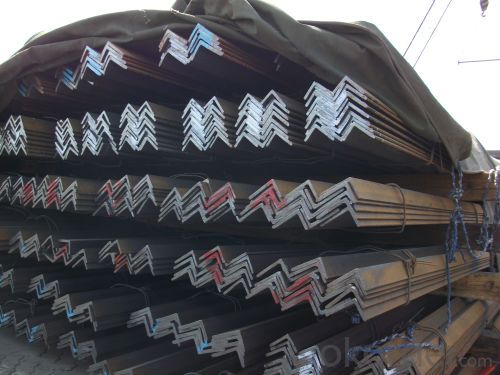
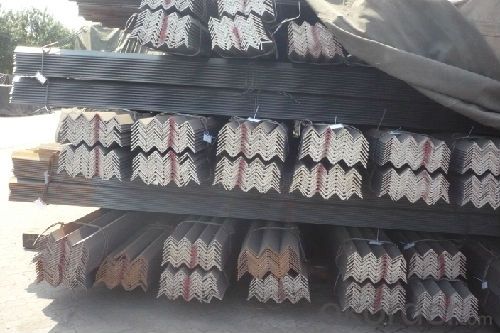
- Q: Can steel angles be used for architectural detailing?
- Indeed, architectural detailing can make use of steel angles. These versatile structural elements find application in diverse architectural scenarios. They serve to provide stability and support to structures, fulfilling framing, bracing, and reinforcing purposes. Examples of steel angle implementation can be observed in architectural features like window frames, door frames, staircases, and handrails, among others. Their inherent strength and durability render them fitting for both interior and exterior architectural designs. Furthermore, steel angles can be effortlessly tailored and manufactured to meet precise design specifications, empowering architects to conceive distinctive and visually appealing architectural details.
- Q: How do steel angles compare to other structural shapes?
- Steel angles are a versatile and commonly used structural shape in construction and engineering, offering several advantages over beams or channels. To begin with, their L-shaped design provides excellent strength and stability, making them ideal for load-bearing applications. They can effectively resist both compressive and tensile forces, making them suitable for a wide range of structural uses. Furthermore, steel angles have a compact and space-saving profile, making them more efficient in terms of material usage compared to beams or channels. This can result in cost savings and reduced weight in construction projects. Moreover, steel angles can be easily customized to fit specific project requirements. They can be cut, welded, drilled, and modified without compromising their structural integrity, allowing for easy integration into various structural systems. Additionally, steel angles offer versatile connection options. They can be bolted, welded, or riveted, providing flexibility in joining them with other structural components, making them suitable for a wide range of building and construction projects. Lastly, steel angles are readily available and cost-effective. They are widely produced and stocked by steel manufacturers, making them easily accessible. Their affordability, combined with their durability and strength, makes them a popular choice for structural applications. In summary, steel angles excel in strength, space-saving design, adaptability, connection options, and cost-effectiveness compared to other structural shapes. Their versatility and performance make them a preferred choice in various construction and engineering projects.
- Q: What is the minimum thickness of a steel angle?
- The minimum thickness of a steel angle typically depends on the specific application and the structural requirements. However, it is generally recommended to have a minimum thickness of around 1/8 inch (3.175 mm) for standard steel angles.
- Q: What are the typical uses for steel angles?
- Various industries and construction projects make extensive use of steel angles. Structural framing is one of the most common applications, where steel angles provide added strength and support to buildings and structures. They play a crucial role in creating bracing, reinforcing, and framing elements like beams, columns, and trusses. Steel angles also find significant use in manufacturing and fabrication. They are employed in the production of machinery, equipment, and vehicles due to their ability to withstand heavy loads without bending or warping. They serve as frames, supports, or brackets for various industrial equipment and machinery. Furthermore, steel angles are widely utilized in furniture manufacturing, particularly in metalwork and carpentry. They function as corner brackets or connectors, offering stability and strength to furniture pieces like tables, chairs, and shelves. Additionally, steel angles are commonly integrated into storage racks and shelving systems to ensure durability and stability when holding heavy loads. In the transportation industry, steel angles are frequently incorporated into the manufacturing of trailers, truck beds, and vehicle frames. Their high strength and resistance to impact and vibrations make them well-suited for these applications, ensuring the longevity and structural integrity of the vehicles. Overall, steel angles have a broad range of uses across various industries and projects. Their versatility, strength, and durability make them a sought-after choice for structural support, manufacturing, furniture construction, and numerous other endeavors that demand robustness and stability.
- Q: How are steel angles protected against corrosion?
- Steel angles can be protected against corrosion through various methods. One common method is the application of a protective coating. This can be done by painting the steel angles with a corrosion-resistant paint or by applying a zinc coating through a process called galvanization. Galvanization involves immersing the steel angles in a bath of molten zinc, which forms a protective layer on the surface of the steel. Another method to protect steel angles against corrosion is by applying a corrosion inhibitor. This involves adding chemicals or compounds to the steel angles that prevent or slow down the corrosion process. Additionally, proper maintenance and regular inspections can help identify and address any signs of corrosion before it can cause significant damage.
- Q: Do steel angles require any special maintenance?
- Steel angles do not require any special maintenance, but proper care and attention can help prolong their lifespan. Regular cleaning to remove dirt, debris, and corrosive substances is recommended. It is also important to inspect the angles for any signs of rust, cracks, or damage, and address them promptly to prevent further deterioration. Applying a protective coating or paint can help prevent corrosion and extend the life of the steel angles. Overall, while steel angles are generally low-maintenance, regular inspections and maintenance practices can help ensure their optimal performance and longevity.
- Q: What is the maximum length for a curved steel angle?
- The maximum length for a curved steel angle depends on several factors, including the diameter of the curve, the thickness of the steel, and the specific requirements of the project or application. In general, the length of a curved steel angle can vary from a few inches to several feet. However, it is important to consult with a structural engineer or a manufacturer to determine the maximum length that can be achieved without compromising the structural integrity of the angle. Additionally, the manufacturing process and equipment available may also play a role in determining the maximum length achievable for a curved steel angle.
- Q: What are the different types of steel angles connections?
- There are several types of steel angle connections, including bolted connections, welded connections, and hybrid connections. Bolted connections use bolts and nuts to join the steel angles together, providing flexibility for disassembly and reassembly. Welded connections involve fusing the steel angles together using heat, creating a strong and permanent connection. Hybrid connections combine both bolted and welded connections, utilizing the benefits of each method for optimal strength and convenience.
- Q: What are the typical lifespan and durability of steel angles?
- The typical lifespan and durability of steel angles can vary depending on various factors such as the quality of the steel, the environment in which they are used, and the level of maintenance they receive. However, steel angles are known for their excellent durability and long lifespan. In general, steel angles are designed to withstand heavy loads and provide structural support in various construction and industrial applications. They are commonly made from carbon steel or stainless steel, both of which are known for their strength and resistance to corrosion. When properly maintained and protected against corrosion, steel angles can last for several decades without significant deterioration. Regular maintenance practices such as cleaning, painting, and applying protective coatings can help extend their lifespan even further. The durability of steel angles is also influenced by the environment in which they are installed. In harsh environments with high levels of moisture, extreme temperatures, or exposure to chemicals, the lifespan may be shorter. However, proper corrosion protection measures can mitigate these effects and ensure a longer lifespan. It is worth noting that steel angles used in marine or offshore applications may have a shorter lifespan compared to those used in less corrosive environments. This is due to the constant exposure to saltwater and harsh weather conditions, which can accelerate corrosion. In summary, steel angles are known for their durability and can have a long lifespan if properly maintained and protected against corrosion. However, the specific lifespan can vary depending on factors such as the quality of the steel, environmental conditions, and maintenance practices.
- Q: How do you store and handle steel angles?
- Steel angles should be stored in a well-ventilated, dry area to prevent rusting. They should be stacked and supported properly to avoid distortion or damage. When handling steel angles, it is important to use appropriate lifting equipment and techniques to ensure safety. Additionally, they should be protected from scratches or dents during transportation and regular inspections should be conducted to identify any issues.
Send your message to us
Low Carbon Prime Steel Unequal Angle Bars
- Loading Port:
- Tianjin
- Payment Terms:
- TT or LC
- Min Order Qty:
- 100 m.t.
- Supply Capability:
- 20000 m.t./month
OKorder Service Pledge
OKorder Financial Service
Similar products
Hot products
Hot Searches
Related keywords
